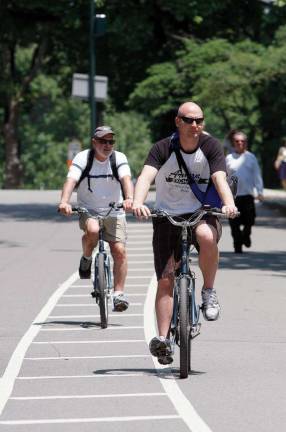More Bikes, Less Cars in Central Park

A new shift is about to once again change the battling dynamic between vehicles, cyclists and pedestrians traveling through Central Park. In the coming weeks, the Central Park Conservancy and the Department of Transportation will be jointly presenting a plan to community boards 7 (Upper West Side) and 8 (Upper East Side) outlining their plans to permanently change the 72nd Street transverse, also known at Terrace Drive. The plan will reduce the number of cars on the road while allowing for an increased number of bicycles. While the idea of more bikes on the park's roadways might raise the ire of some local residents, the plan was actually conceived as a way to encourage cyclists off the pedestrian and shared paths and back onto the road. "The purpose of this plan-developed in conjunction with DOT and Parks Department-is to encourage bicyclists to use the drives instead of interior pedestrian paths," said Dena Libner, spokesperson for the Central Park Conservancy. "More bike access on the drives, we believe, should help in accomplishing this." Currently, the drive accommodates two lanes of vehicle traffic and one bike lane, with a fence between the bike lane and the pedestrian path on the south side. Each vehicle lane is 11 feet wide, with a three-foot buffer between the cars and the eight-foot-wide bike path. The new plan will create wider buffer zones, with the intent to allow more bicycles and keep pedestrians safer, and allow bikers to travel both east and west on 72nd Street. Two lanes of traffic will become one single 11-foot-wide lane, with a four-foot shoulder on the north side and a four-foot buffer on the other, separating the cars from the double bike lanes. Each bike lane, divided by a dotted line, will be slightly narrower than the previous one, at seven feet wide each. The DOT has already conducted a traffic study to determine the Loss of Service (LOS) rate that will result in narrowing the road for drivers. Right now, an average of about 500 cars travel on Terrace Drive during the morning peak hours of 8?9:30 a.m., with an average delay of 9.8 seconds. Using this as a benchmark, the DOT estimates that the LOS level will be a "B" on an A-F scale, with A being the current condition and F being the worst possible, meaning the changes will produce "reasonably unimpeded traffic with average travel speeds about 20 percent less" than current, with an average delay of 13 seconds for the same number of cars. In other words, if the projections hold, cross-park car trips may only be held up by an additional 3.2 seconds, on average, as a result of this change. The Parks Department and the Conservancy have implemented several changes recently to address the increasing numbers of cyclists crossing the park on a daily basis as well as the safety concerns of pedestrians who don't want to share paths with bicycles zooming past. Earlier this year, the park debuted a newly shared path for bicyclists and pedestrians to cross the park at 96th Street, in answer to bicyclists demanding safer cross-park routes. It faced some severe opposition from both East and West Side community board members, but so far has not caused major controversy in action. While the CPC will be presenting the plan to the community boards and listening to feedback, the new configuration is already slated to switch over in the coming months and is designed to stay. "This change will be permanent," Libner confirmed. "We expect more cyclists to use the drive for cross-park commutes and travel, and pedestrians to be able to navigate interior paths with greater ease."